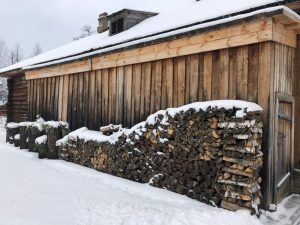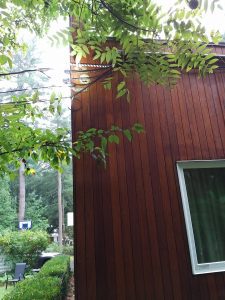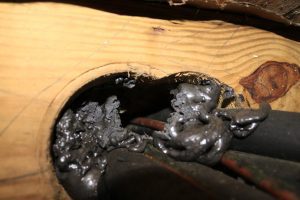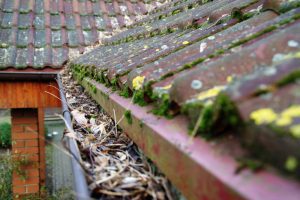TACKLING SPRING CHORES – WITH PESTS IN MIND!
By Chris Williams on March 27, 2019.
In the yard itself –

Shutterstock
1. Move firewood piles away from the house – If you moved your firewood close to the house this winter for convenience, now is the time to get that wood farther away since firewood piles attract all kinds of pests and invite wood-feeding insects that could have an eye on your house next. Stack firewood and any similar building materials on a platform up off of the ground.
2. Resist the urge to pile on when using mulch – Pests love mulch, especially insects and other arthropods (pillbugs, earwigs, millipedes, crickets, etc.) that need high moisture levels and like to live around your home’s foundation. Try to leave a mulch-free border at least a foot wide next to your foundation and keep the mulch shallow. Mulch that is too deep may never dry out.

Overgrown Walnut tree allowed easy access for squirrels to enter the home.
3. Prune branches touching the house – Any branches that touch your house can serve as a highway for squirrels, other rodents, and even ants to move from trees onto your house where they can enter around the rooflines or other openings. Ivy growing up walls serves the same purpose, pest-wise. Trim back tree and shrub branches. Ideally, ivy should be removed from walls.
On the house exterior –
1. Check screens and door fitting – Make sure screens fit tightly and patch any holes in screens. Outside doors, especially ground floor doors, should have thresholds or sweeps at the bottom to keep out pests. Install new weatherproofing strips and caulk any crevices around the frame.
2. Pay special attention to the garage door – Garage doors may be the number one entry point for pests. Replace any worn rubber thresholds at the bottom of the door and seal gaps around the side of the door.

Mice chewed through insulation foam around Air Conditioning lines into a basement. Z. Ciras
3. Look for gaps and cracks around the foundation – Walk around your home, looking for places where pipes, cables, and electrical lines enter your home. Use caulk or metal stuffing (steel wool, copper) to plug gaps around these lines. Mice and other pests use these conduits as direct routes to get inside and will follow pipes and lines through wall voids. Fill, seal, or screen any cracks or other openings around the foundation.
4. Check vents – Spring is nesting season for birds and certain birds do love to nest in broken vents on roofs and exterior walls. Make sure that roof, crawlspace, exhaust and foundation vents are screened. Dryer vents should not be screened due to a lint fire hazard but can be fitted with a special flapper valve to prevent nesting birds.

Shutterstock
5. Clean roof gutters and downspouts – Mosquitoes and the diseases they spread are more of a concern these days. Clogged gutters hold water and can serve as a close-by breeding site for mosquitoes and drain flies.
If you want to upscale your spring cleaning and really pest-proof your home for the coming summer, give Colonial Pest a call and ask for our pest exclusion specialists. These technicians specialize in finding places and conditions that allow pests into your home and eliminate them by screening, sealing, reinforcing, and replacing materials – guaranteed to keep pests out.
Spring is a good time for this professional pest-proofing of your home. And, if you’re not already one of our many Preventative Maintenance Program customers, spring is the time to sign on for our twice yearly perimeter treatments of your home. Ask us for more information on this latest concept in pest protection.